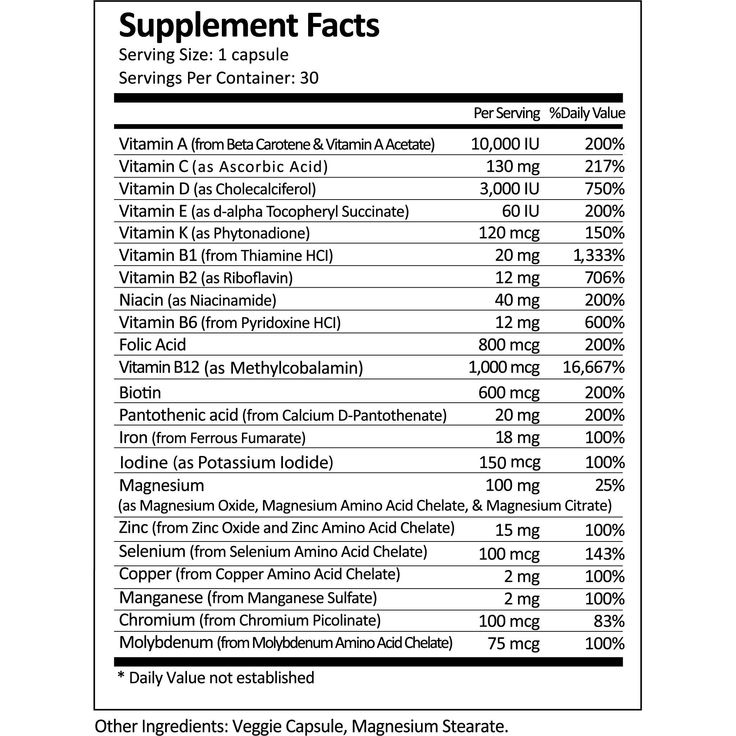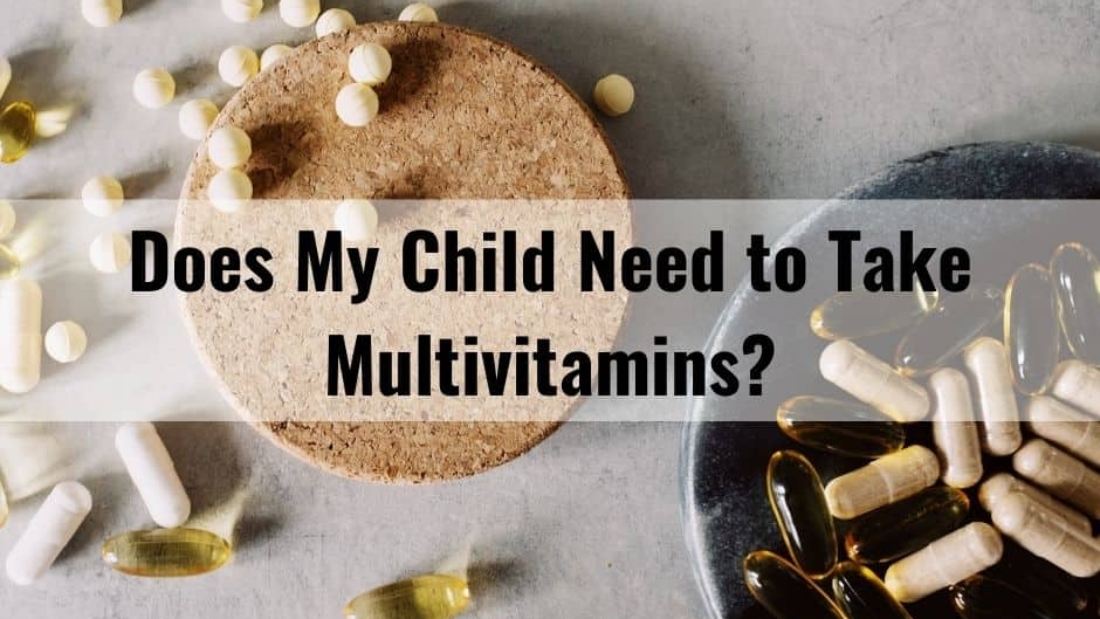If you have a toddler who has a meltdown at the thought of eating more than two bites of something green, you know that getting children to eat a well-balanced diet isn’t easy. Whether to start giving your child vitamins is a question many parents have, as well as at what age they should start? Which brand to choose? What should be in multivitamins? However, for most healthy children, vitamins are unnecessary.
According to the American Academy of Pediatrics, children receiving a normal, well-rounded diet do not need vitamin supplements at all. Still, it can be difficult to know how many vitamins your child is getting each week. A toddler’s plate after dinner is finished may look like a crime scene. Did they actually consume any of that broccoli, or did it just get pushed around?
REASONS TO GIVE YOUR CHILD A MULTIVITAMIN
When parents aren’t sure their children are getting the proper nutrients to achieve good health, their first route will immediately jump to a multivitamin. In my Peaceful Mealtimes online course, I teach parents how to analyze their child’s diet, they often find their “picky eater” is actually getting more variety than they initially thought. But under certain circumstances, some children don’t eat a normal, well-balanced diet, and may need to supplement with vitamins or minerals, such as those who:
- are extreme picky eater and struggle to eat a variety diet
- have food allergy
- follow a vegetarian or vegan diet
- have abnormal growth pattern
- have a medical or digestive condition that affects the absorption of or increases the need for nutrients, such as celiac disease, cystic fibrosis, inflammatory bowel disease (IBD) or cancer
If your picky eater has a poor appetite or has been omitting whole food groups for a long period of time, you will likely need to temporarily support them with a multivitamin as picky eater may experience with low intake of zinc and iron.
Children who follow vegetarian or vegan diets may need to take specific supplement (ex: vitamin B12 – found in animal foods). Another example, if a child who doesn’t consume seafood, I may recommend supplementation with Omega-3 fatty acids (DHA & EPA). For a child who is allergic dairy or does not consume dairy products, I’d recommend vitamin D and calcium.
If your child is experiencing declining or stagnant growth on their growth curve, it could mean that they’re not absorbing nutrients (medical or digestive problems) or their appetite is low due to a mineral deficiency (ex: iron deficiency anemia).
Children who have inflammatory bowel disease or celiac disease might have difficulty absorbing several minerals and vitamins like vitamin D, calcium, iron and zinc. It is because the diseases cause damage to the areas of the gut which absorb micro-nutrients. Additionally, kids with cystic fibrosis have trouble absorbing fat and may not absorb fat-soluble vitamins – A, D, E, and K. Children who take certain medications that interfere with intake may need a supplement.
Giving a multivitamin with various vitamins and minerals that aren’t actually targeted at what your child needs based on what is lacking in their intake is like shooting in the dark. You’re unlikely to actually see good results! Instead, work with dietitian to analyze your child’s diet, and help you find targeted supplements that might help.
THE RISK OF TAKING TOO MUCH SUPPLEMENT
MegaDose
A lot of marketing companies are constantly trying to convince us that children are just generally “picky” and need a multivitamin to fill the nutrition gap. And often these marketing campaigns are targeted at children themselves and their apparent need for a wide range of low dose multivitamins. This type of marketing can be very misleading, especially if you have a fairly healthy child that is eating a generally varied diet as is. As a result, parents may be spending money on something that is just not needed, or risking giving their children too many vitamins, resulting in overdose on certain vitamins, especially Vitamins A, D, E and K. Be very careful when you see a multivitamin that contains 100% of a vitamin/mineral dose per day or more (even when ingredients, etc. look great! See example here).

Not a magic pill
Some parents also treat multivitamins as an insurance policy, a way to ease a parent’s worry. But, it can also mask the underlying problem of an extremely unhealthy eating habit, no supplement can replace feeding kids a well-balanced diet.
Avoid artificial colours and sugar
So many popular multivitamins out there are just full of sugar, dyes and fillers. You want your children’s multivitamin to taste good enough that they’ll take it, but you’ll also want to avoid products that are high in sugar and/or include artificial sweeteners like high fructose corn syrup or Aspartame. Also, the sugars in gummy vitamins can contribute to dental cavities.
Never refer to vitamins as ‘candy’
Finally, the fact that many look and taste exactly like candy. Always read the label on the back for how many vitamins your child should be taking (usually one a day) and keep them out of sight of your children, as kids often think of them as candy and try to eat more than one per day.
WHAT AGE SHOULD MY CHILD START TAKING VITAMINS?
I know we all want to do the best for our children but if your child eats a healthy, well-balanced diet, they don’t need vitamin supplements. However, infants do have different nutrient needs than older children and may require supplements. For example, some breastfed babies need a vitamin D supplement.
It’s important to ask your pediatrician if your child may require any supplementation, and always check with your child’s doctor first before administering any vitamins or supplements.
WHAT SHOULD I LOOK FOR?
The National Pharmaceutical Regulatory Agency (NPRA) under the Ministry of Health Malaysia (MOH) is the only agency to regulate the registration, licensing, surveillance and quality control as well as Good Manufacturing Practice of supplements in Malaysia.
Every health supplement registered with MOH has two key features. The first key feature is the registration number (known as the MAL registration number) that starts with the letters MAL followed by eight digits ending with the letter N (ex: MAL 12345678 N). The letter “N” at the end of the MAL registration number indicates the type of product, which in this case stands for “supplements”.
The second key feature of registered health supplements is the presence of a “MOH Hologram” sticker on the packaging. This hologram sticker is considered a safety feature for all MOH registered health products as it is highly sophisticated and cannot be replicated.
When selecting a child’s multivitamin, you’ll be looking two options: with and without iron. The choice is yours based on your child’s diet and the perspective of their pediatrician. Most vitamins are water-soluble, which means that your child will simply eliminate whatever they don’t need in their urine. But vitamins A, D, E, and K are stored in the body’s fat. This means that there is a risk of toxicity (levels higher than the recommended). So, when buying a multivitamin, be sure to look at the label. You want to avoid multivitamins that contain more than 100% of the daily value of vitamin (especially of the fat-soluble ones).
Try your best to avoid any artificial colours and dyes that come in a multivitamin or supplement. Be aware that again, there are a lot of multivitamins that are very much like candy and full of sugar.
Third-Party Testing
Supplements that are third-party tested are sent to a lab where they are tested to ensure they contain what they say they contain and are not contaminated with specific high-risk, common contaminants. However, it’s important to note:
- Third party testing does not test to see if a product is effective or safe for everyone, and it does not ensure the supplement will not interact with other supplements or medications.
- Not all third-party testing is created equal. It is not uncommon for supplement companies to pay labs for certificates after conducting minimal to no testing.
- The third party certifications we can trust are: ConsumerLab, NSF, and USP. However, these certifications are difficult to obtain and/or expensive for manufacturers, so many companies choose not to get their products tested by one of these three organizations.
- Sometimes products tested by these three companies are more expensive to try to offset the cost they pay for certification.
- Just because a supplement is not tested by one of these three companies, it does not mean it’s a bad product. We recommend doing some research on the reputability of the manufacturer, and calling up the manufacturer and their testing lab to determine their protocols and decide if you feel comfortable consuming the supplement.
Form
Multivitamins come in a variety of forms:
- Chewables
- Gummies
- Liquid
- Powdered
The one you choose will be up to you depending on what your child accepts more easily and what the vitamin content of each one is.
For example, most kids enjoy chewable gummies, however they usually contain a bit more sugar than other versions. That being said, this may be the only way you can consistently get your child to take the vitamins, and so in that case, it may be worth it to purchase these. However, gummies don’t usually have high levels of iron in them. You also want to be conscious of the fact that gummies are a choking hazard for kids under 4, so if offering them, chop it up into smaller pieces to make it safer for younger children.
Chewable tablet vitamins tend to have higher iron doses, so pay attention to this if this is a main nutrient of concern for your child. The liquid and powdered supplements can come in many flavours and parents often find that mixing them into a smoothie or yogurt is the best way to get it in. The trick here is, making sure your child takes the smoothie or yogurt + vitamin mixture daily!
Of course, taking into consideration cost of a product, accessibility, as well as all the other factors described above is going to be important and individual to every family. Weight out your pros and cons and remember to consult a doctor or dietitian for specific advice.
BOTTOM LINE
Research tells us that for healthy toddlers, a nutritious diet is the best way to be getting all the vitamins and minerals they need. Whole foods offer more/better absorbed nutrients than multivitamins can offer. So generally speaking, if your child is healthy (growing along their growth curve, no medical/nutritional diagnosis), eats a decent variety of foods, is active and sees a doctor regularly, they should not need a multivitamin.
Finally, if you have a picky eater, or are unsure of how to feed your toddler or what to feed your toddler to raise a healthy, happy eater, you can check out my Peaceful Mealtimes course for help. You will learn how to slowly begin introducing more fresh, whole foods to your toddler so that eventually, they may not need to rely on a multivitamin anymore.


Leave A Comment